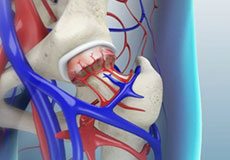
Avascular necrosis, also known as AVN and osteonecrosis, is a disease caused from inadequate blood supply to the bone which leads to bone death.
This disease is most common in adults aged 30-60 but can also occur in children, mainly from cancer therapy. It can affect one or more bones and if left untreated, it can lead to destruction of the adjacent bones, tissues and joints.
Causes
AVN is caused from insufficient blood supply to the bone leading to a loss of minerals and nutrients which normally keep bones healthy.
The common causes of avascular necrosis in children include:
- Trauma: Dislocation or bone fractures can injure blood vessels
- Long term or high dose steroid treatment
- Cancer treatments: Radiation or chemotherapy
- Blood disorders such as sickle cell anaemia and leukaemia
Symptoms
In the early stages of AVN, there are no symptoms. As the disease progresses, your child may experience the following symptoms:
- Joint pain that gradually increases
- Pain which occurs even at rest
- Limping and groin pain if the hip joint is involved
- Restricted range of motion
Diagnosis
After your doctor performs a physical examination, the following diagnostic procedures may be ordered:
- Imaging tests:
Imaging tests such as X-ray, magnetic resonance imaging (MRI), and computed tomography (CT) scan can determine the extent of bone damage and if the disease has spread to the surrounding tissues. - Bone scan:
A small amount of radioactive material is injected into a blood vessel which collects in the bone. A special camera takes pictures of the affected areas of bone. - Biopsy:
A tissue sample is removed and sent for microscopic examination to rule out the presence of cancer cells in the bone.
Your surgeon may recommend non-surgical or surgical methods for treating avascular necrosis.
Non-Surgical Treatment includes:
- Medications:
Nonsteroidal anti-inflammatory drugs (NSAIDs) may be taken to relieve pain. Children with blood clotting diseases will be given blood thinners (anti-coagulants) to dissolve the clots. - Reduced weight bearing:
Your doctor may recommend rest and use of crutches to reduce weight on the affected bone in order to promote natural healing. It also helps to delay surgery in some children. - Range-of-motion exercises
can gradually improve movement of the restricted area. - Electrical stimulation:
Electric currents can induce bone growth. It may also be used during surgery where it can be applied to the damaged bone directly.
Non-surgical modalities may slow the disease progression but most patients will require surgery.
Surgical Treatment options include:
- Bone grafting:
This surgery replaces diseased bone with healthy bone, taken from the patient or from a bone bank, to increase blood supply to the affected area. - Vascular grafting:
Bone along with blood vessels and arteries are surgically transplanted to the affected bone providing an immediate blood supply to the area. - Arthroplasty or total joint replacement:
This procedure is performed only when all other treatments are unsuccessful and when the joint is completely destroyed. The joint is replaced with artificial implants. - Bone resurfacing:
The femoral head is reshaped and implanted with a metal cap. This implant is reshaped to match the size of the femoral head. This helps to preserve the bone or joint, prevent fractures, and decrease risk of dislocation. - Core decompression:
In this surgery, the inner part of the bone is removed thereby reducing pressure within the bone, increasing blood flow, and helping to form new blood vessels. This procedure relieves pain and slows the progression of bone and joint destruction and is best done in the early stages of AVN. - Osteotomy:
This is the surgical cutting and reshaping of the bone to reduce stress on the affected area. The affected area is rotated and turned in such a way that another portion of the bone becomes the new weight-bearing area. It is done on a small area of affected bone.





